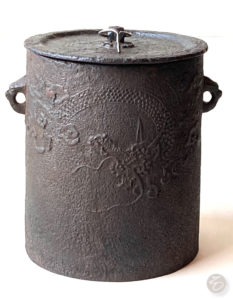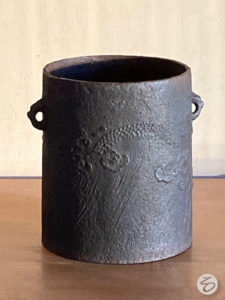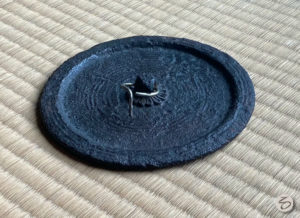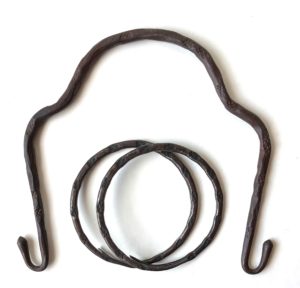Unryū Gama

The unryū gama has a form that is unlike the many standard models used in Chanoyu, when it was created in the 16th century by Sen no Rikyū. The pictured kama is used with the ro, 炉, hearth, and there are smaller versions used with the fu-ro, 風炉, wind-hearth. In March, Urasenke uses a tsuri-gama, 釣釜, suspend-kettle, and quite often the unryū-gama is the preferred choice.
![]()

It is recorded that Sen no Rikyū had the kettle made to copy a mizu-sashi, 水指, water-indicate, that was in the possession of Take-no Jō-ō, 武野紹鴎, War-field Help-gull. The mizusashi was a Chinese blue and white porcelain vessel with an image of a dragon in clouds, which was a very familiar object in China during the Ming dynasty.

The lid has a depressed central surface with a diameter of 4 sun kane-jaku. The depth of the inner surface is one bu kane-jaku. The lid has dimensions of 4 and 5, which have broad symbolism, and when added total 9, which also has profound significance. The appearance of the lid with the broad rim suggests that it is a vessel with thick walls. The kama is a water vessel.
The lid has an escutcheon, za, 座, seat, in the form of a kiku, 菊, chrysanthemum, flower, with thirteen petals: diam. one sun kane-jaku, or 8 bu kujira-jaku. Similar kettles have flowers with various numbers of petals. The flower is emblematic of kiku–sui, 菊水, chrysanthemum-water, an ancient symbol of rejuvenation. The kiku is important as an emblem of the emperor, especially the chrysanthemum flower with sixteen and the thirty-two petals, which is symbolic of his presence in all directions, his omnipresence. The image suggests that a chrysanthemum flower has fallen on the surface of the water causing ripples to circle to the rim, and because of the chrysanthemum, outward to infinity. That is why there are rings on the band of the rim.
The kettle was modeled on a water jar. The word kiku also means ‘listen,’ ‘hear,’ ‘pay attention to,’ etc., which may allude to hearing the sound of water simmering in the kettle, which is called matsu-kaze, 松風, pine-wind. Perhaps it is just the presence of the flower for the word kiku, rather than the importance of the number of petals.
Various meanings of the word kiku, for the Kanji, 聞, are to hear, to ask, to enquire, to query, to follow (advice, order, etc.), to obey, to listen to, to comply with, etc. Another Kanji that is read kiku, 聴, means careful inquiry. The word kiku may allude to paying close attention when consulting the Ekikyō.
The unryū gama iron lid has a small, cubic knob called a tsumami, 摘み, pinch, that measures 5 bu kane-jaku. The knob has a hole that holds a loose ring called a kaki-tate-kan, 掻き立て鐶, poke-up-ring. The ring has a small ‘leg’ that holds up the ring making it easier to pick up the lid. The diameter of the ring is 9 bu kane-jaku, the length of the leg including the bend is 7 bu kane.
The knob is a cube with the eight corners removed, which is a cuboctahedron, ri-ppō hachi-men-tai, 立方八面体, stand-direction eight-face-body, which is a form made of fourteen facets – six squares and eight equilateral triangles.
Six is the number that is symbolic of Infinity in Time, and eight is the number of Infinity in Space. The tsumami has a hole through it to loosely hold as metal ring. The kettle is made of iron and the ring is appears to be made of steel, although other models have iron rings. The ring is a continuous wire that is shaped into a circle that is turned to form a leg. This style of tsumami is rarely present on kama used in Chanoyu, so that its presence may have some special significance.
The eight triangles of the tsumami may be identified with the three lines of the trigrams of the Eki-kyō, 易経, Change-sutra. It should be remembered that Rikyū’s personal name was Sō–eki, 宗易, Sect-change, which indicates that he was deeply associated with it.
In the Eki-kyō there are ha-kke, 八卦, eight-[divination] signs, called trigrams because they are composed of three lines. These eight signs are identified with primal aspects of nature. There are two kinds of lines. One is solid, which is identified as Yō, 陽, Positive, and one broken or with two parts, that is identified as In, 陰, Negative. There are eight different combinations of these three lines combining the In and Yō lines. In determining an outcome, two trigrams are combined to form sixty-four hexagrams, which have six lines of combined In and Yō lines. When divining, fifty sticks or three coins are used. Depending on the outcome, some lines may be identified as changing from In to Yō or the opposite. This is the core of the Ekikyō.
The form of the tsumami is rather like a die, as in the number dice cube, called sai-koro, 骰子 and賽子, dice/of, usually written in kana, サイコロ. The word sai with the Kanji 賽 also means a temple visit.
The unryū gama lid tsumami knob has fourteen sides: six squares and eight triangles. Throughout the world, people have created dice with different numbers of surfaces. The ancient Chinese had a ceramic die with fourteen sides, with characters on each side; jū-yon-men sai-koro, 十四面 骰子, ten-four-face die-of, which may have been used in divining the I Ching. Rikyū’s choice of the fourteen-sided tsumami may have been influenced such a device. However, an early choice for the means of divining the Ekikyō was fifty bamboo sticks called zei-chiku, 筮竹, divine-bamboo. When the sticks are used, one is set aside and not used, so that forty-nine, an odd number, are used. The length of the standard hi-shaku, 柄杓, handle-ladle, is 14 sun kane-jaku, as is the width of the ro, 炉, hearth.
The tsuri-gama, 釣釜, hanging-kettle, has a pair of kan, 鐶, metal rings, to hang from a metal tsuru, 弦, bowstring, hung from a hook attached to a chain or bamboo pole. The presence of the kan attached to the kama is the only time that the detachable kan are present in the Tea room. There are pairs of rings on the furo that are loose but permanently part of the container. Not only are there kan present on the hanging kettle, but traditionally the kan are larger than the customary metal rings. This again suggests a meaning greater than having the usual smaller metal rings.
The height of the kama body is 6 sun kane-jaku; with the lid is 6.1 sun kane. The thickness of the lid is 1 sun kane. The diameter of the bottom of the kama is 5.1 sun kane, and the kama mouth opening is 4.9 sun kane, so that the sides of the kettle taper inward very slightly. The diameter of the lid is 5 sun kane, and it extends a little beyond the mouth opening of the kama. The lid has a raised, flat band around the perimeter, with a flat inner surface. This suggests water near the brim of the walls of a vessel, evoking the mizusashi. What is the significance of relationship between the water, the chrysanthemum flower, the geometric knob, and the ring?
The kama height is 6 sun kane – the distance from the lid to the underside of the tsuru is 8 sun kane. The measurements are six and eight. These two numbers can be identified with the cuboctahedron, which has six squares and eight triangles. In the Ekikyō there are six lines in a hexagram, and eight divination signs, ke, 卦, sign. The kama is 6 sun, and is a physical solid, the empty space above is 8 sun. Both numbers are In, as they can be equally divided in half. The numbers 6 and 8 divided in half are 3 and 4. Yō and In. The sweets are served in a fuchi-daka, 縁高, edge-high, which manifests the numbers 6 and 8.
When using bamboo sticks with the Ekikyō, fifty sticks are used, and one of the sticks is set aside and not used in the procedure. The diameter of the kama lid is 5 sun kane or 50 bu kane, and when the lid is removed, it reveals the mouth of the kama with a diameter of 49 bu, the number of sticks used with the Ekikyō.
The diameter of the unryū gama lid of go-sun, 五寸, five-span, may allude to the Go-gyō, 五行, Five-transitions, or physical elements, and the Go-rin, 五輪, Five-rings, or principles, which are integral parts of the Ekikyō.
The principal motif of the kettle is the image of a dragon in clouds. Dragons bring rain. They are symbols of enlightenment, the emperor is likened to a dragon, and only he can wear the design of a yellow dragon. The design of the unryū gama depicts rain falling from the dragon and clouds. The kama has lugs, kan-tsuki, 鐶付, metal ring-attach, for metal rings to be inserted to move the vessel. The form of the lugs are most often in the form called ki-men, 鬼面, demon-face, which may be identified as dragons. The Chinese nation has the dragon as a symbol of the country, and the Chinese call themselves the descendants of the dragon. The first hexagram of the I Ching is of Ken-ke, 乾卦, Heaven-sign, which identifies the six Yō lines as riku-ryū, 六龍, six dragons; three above and three below. It instructs their meaning and uses.
A dragon has scales, uroko, 鱗, that are like those of the koi, 鯉, carp. In a very formal Tea presentation using the furo, the ash bed in the furo is covered with a pattern of ash forms that are called uroko bai, 鱗灰, scale ash, which identifies the furo with a koi fish or a dragon.
A kan is a metal ring or circle, wa, 輪, and are used to move a kettle. It is customary to use the ō-kan, 大鐶, large-metal rings, with the hanging kettle; they have a diameter of 3.5 sun kane–jaku or 2.8 sun kujira-jaku. The length of the ōkan when straightened flat is 11.875 sun kane-jaku, or 9.5 sun kujira-jaku. this equals 19 units of 5 bu kujira-jaku. The length of standard hi-bashi, 火箸, fire-rods, is 9.5 sun kane-jaku. The diameter of the ōkan is an average of 3.5 sun kane or 2.8 sun kujira, and a radius of 1.4 sun kujira.
In Buddhism there are various periods of mourning. The initial periods are seven weeks after death, and these periods are guarded by thirteen different deities- the Jū-san-butsu, 十三仏, Ten-three-Buddhas. The second week is guarded by Shaka Nyorai, the Buddha.
In the Ekikyō, when dividing the 49 sticks, they are divided in half, and one half is taken four at a time until there are three or fewer sticks left. This results in the numbers 6, 7, 8, or 9, and 9 is the highest number attainable. The number 6 which is In, and 9 which is Yō change. Numbers 7 and 8 are stable and do not change. This is at the heart of the Ekikyō. Three lines make up a trigram, and two trigrams are combined to form a hexagram. If a hexagram is made of six 9 Yō lines, then all lines would change to six 6 In lines, which is the hexagram Kon, 坤, Earth.


The tsuri-gama harp tsuru resembles somewhat an ancient Chinese lobed design called a Kara-kan, 唐鐶, Tang-metal ring.
The image of the dragon on the surface of the body of the kama illustrates that the dragon is moving from right to left, which would be the equivalent of clockwise when seen from above. In most of the Jiajing vessels the dragon is depicted as though moving from right to left. Some Chinese dragon vessels there are often two or more dragons shown.
The ryū-zu, 竜頭, dragon-head, head establishes the shō-men, 正面, true-face. If the dragon originates in the east and moves to the west by way of the north – the dragon that guards the east is the Sei-ryū, 青龍, Azur-dragon. When two dragons are depicted, they are often shown facing each other, and frequently with the hōju between them. One or two dragons are often depicted as the lug on the top of a temple bell. The dragon of the east is identified with Wood of the Five Elements.

Takeno Jō-ō’s mizusashi was one of the Ming Chinese water vessels that were made for long periods of time in official Chinese royal factory kilns, and were made in various sizes with similar dragon motifs. Note that the interior vessel is unglazed, which indicates that it was intended to be an incense burner filled with ash, and used often as tomb offerings. The wall body appears to be rather thick, as the lid of kama suggests. In China, such vessels were part of tomb fixtures, and some were used as incense burners and filled with ash, which is the reason the interior is unglazed. The incense offerings were for the most part, sen-kō, 線香, stick-incense. Some containers had walls that were about one inch thick. Such vessels have been also used containing water for raising lotus plants and goldfish, a custom found in Japan. The carp fish, koi, and some goldfish are likened to dragons.
Possible models for the mizusashi of Takeno Jō-ō can be found on the internet searching 嘉靖龍缸領銜. These are identified in English as dragon jars. They were large, ranging from a diameter of 2 to 3 shaku kane-jaku, and difficult to produce. These were made during the reign of the Ming Emperor Jia-jing, Jpn. Ka-sei, 嘉靖, Praise-peace, 1507 –1567, and in the time of Emperor Wanli, c. 1599. The dragon design pattern is identified as ‘Jiajing,’ after the emperor in whose era was created.
As the vessel was created to be open, the container did not need or have a lid. The unryū kettle illustrates that condition as the concentric rings are intended to depict water in an open vessel. The Seto hitoe guchi, 単口, single-opening, mizusashi has no lid, and the ceramic body of the vessel has rings from when it was thrown, and these also suggest ripples of water.
For more information on Tea and Japanese culture in March, see also: Tea in March, Tea in March Part 2, Unryū Gama – A Petal Puzzle, Unryū Gama Picture Gallery, and Rikyū’s Take Jizai (video).

